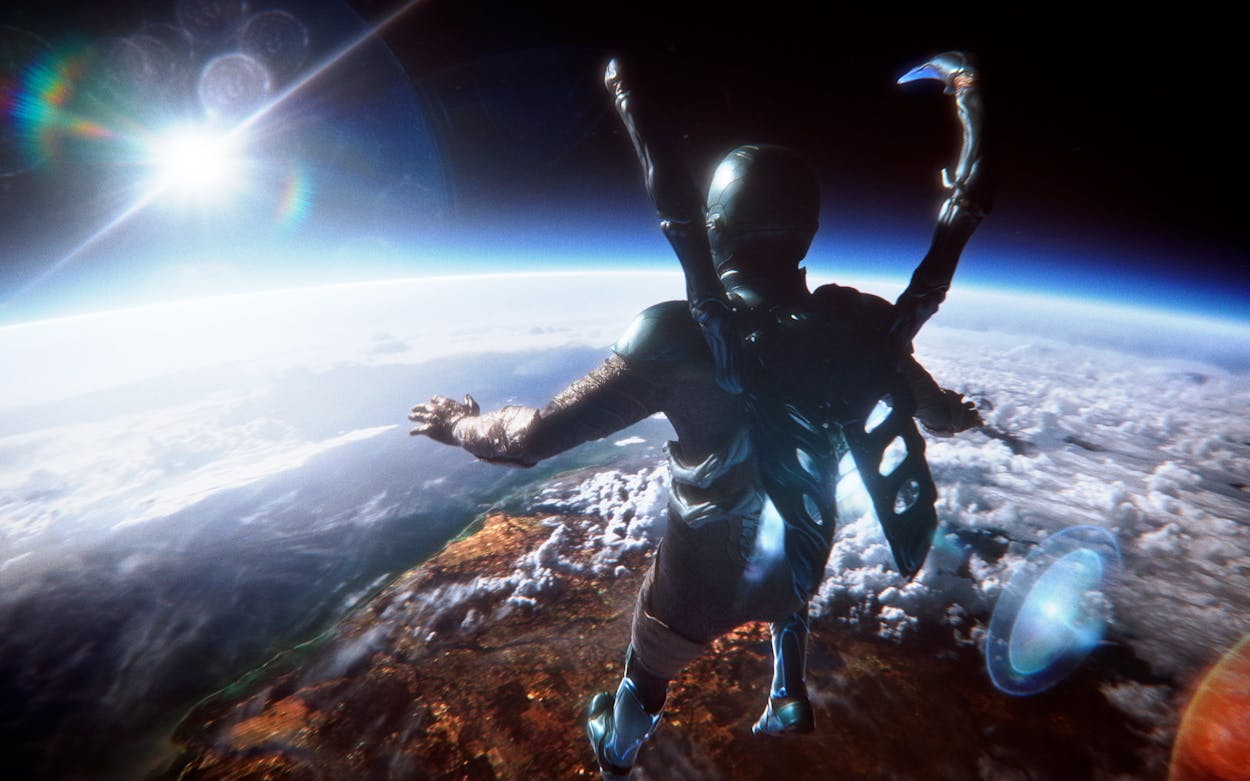In 2018, like many Latino comic book and sci-fi/fantasy fans, I was thrilled when DC Studios announced a Blue Beetle movie featuring Mexican American teenager Jaime Reyes’s iteration of the character. The flick, which comes to theaters August 18, would be the first movie to feature a live-action Latino superhero. In a world where, for more than ten years, Marvel released up to three movies and streaming TV shows annually featuring wealthy playboys, demigods, mutants, and celestial beings, finally fans would see a non-animated motion picture focused on a Latino superhero.
My hope was that the filmmakers would provide moviegoers and comic book readers with a worthy successor to the greatest superhero movie ever made—the animated Spider-Man: Into the Spiderverse, featuring the popular Afro-Rican teenager Miles Morales’s Spidey. I teared up with pride after watching that movie. I had waited more than forty years to see a Latino superhero, specifically a fellow Puerto Rican, on the big screen. My son had a different perspective. He had grown up reading about the adventures of Marvel Comics’ Miles Morales and DC Comics’ Jaime Reyes. “It’s okay, Papi. I love you,” he said from the back seat of the car. “But it’s no big deal,” he continued, as he put his hand on my shoulder. For him, Morales’s Spider-Man was simply a part of life. It wasn’t an exception; it wasn’t revelatory. In Spiderverse, as in the comics, Miles Morales is from Brooklyn. The setting grounds the character. It gives readers a real-life connection to the superhero. They can see themselves in Morales; I know it’s helped my son, a Brooklyn boy himself. I was eager to see a Texas town featured prominently in a live-action superhero movie—to think of all the young folks across the state who would see themselves in Reyes.
But this week, with the release of the Blue Beetle trailer, comic book fans learned that the movie’s setting isn’t El Paso, the canonical home of Jaime Reyes/Blue Beetle. Instead, the film’s Reyes lives in the fictional Palmera City, a futuristic beach town decked out in palm trees and neon-lined buildings. It’s meant to transport viewers into an alternate universe detached from the complexities and mundanities of daily life. It’s an escape, which is something a real-life city can’t provide. I’m not the only one who took this change as a mistake. Twitter backlash was fierce and swift. My friend David O. Bowles, a Mexican American scholar and author of books such as My Two Border Towns, put it best: “No mames, DC.” A genteel translation might be “Stop messing around, DC,” though it might be better as “Get the f— out, DC.” Another user wrote, “They couldn’t just let us keep our hero.”
Thankfully, other key elements of Blue Beetle have stayed true to the comics. Reyes, played by Xolo Maridueña, is a teenager, which adds an emotional, uncertain element that resonates with readers. He is differentiated further as the third Blue Beetle—and the first white one. But he is the first with supernatural abilities, which are derived from a technologically advanced alien scarab that attaches itself to the kid. Reyes is a host. The scarab creates an armored costume. It grows wings. The technorganic suit’s hands turn into cannons. The scarab is also sentient, with a knack for assessing everything as a threat to which the only response is outrageous violence. Reyes must learn to control the unpredictable scarab like a teenager needs to regulate his or her emotions while developing into an independent individual.
Best of all is that Reyes is from El Paso, a city between worlds. It’s neither the U.S. nor Mexico but both. El Paso as Reyes’s home speaks to the multigenerational immigrant experience in a border town. The West Texas border town is important to my family and to Latino kids across the state. Too often El Paso is forgotten, relegated to intangible, almost unreachable status until it makes the news as a result of a massacre or mass migrant crossings. That’s not the El Paso I know. It’s not the El Paso that my family knows. It’s at El Paso that my wife’s family crossed into the U.S. during the Mexican Revolution. It’s where they settled before relocating to East Los Angeles then eventually returning to the Sun City, where her parents met. El Paso is also essential to the comic book and to Reyes. As in the case of my in-laws, it was a liminal and dynamic space, a refuge for the family but one always in flux, as is every border town and every pubescent child.
Director Angel Manuel Soto thinks otherwise. Although he visited El Paso to get a sense for the city, Soto ultimately chose to conjure a fictional sci-fi landscape in a paradise-like shawl. As Soto told the press during the trailer’s screening: “To bring Palmera City to the screen is fantastic in its own regard, because Jaime, as we were discussing, Blue Beetle—the vision was to have Blue Beetle be on the same level as someone like a Superman or a Batman who have Gotham or Metropolis or cities that are the beating hearts of the themes of the comics, and to create a world for Jaime.” But Reyes has a city that is at the beating heart of the themes of his comics: El Paso. Moving Blue Beetle’s home to a fictional environment does a disservice to Jaime Reyes, to El Paso, to the immigrant experience, and to Texas. Soto and DC Studios took a critical component of Jaime Reyes’s story and dismissed it. Unfortunately, that’s a tactic with which El Pasoans and Latinos are all too familiar.








